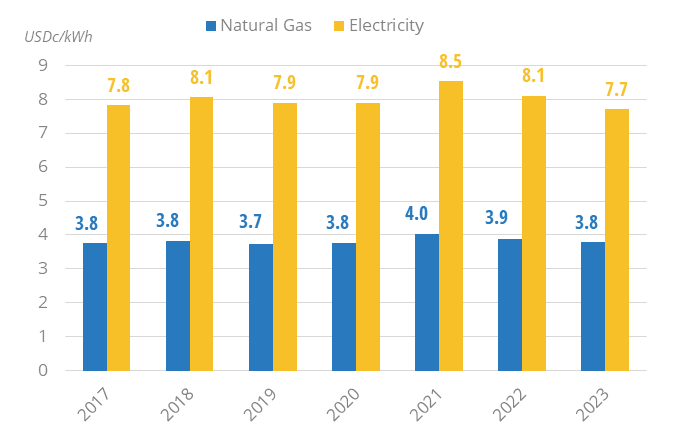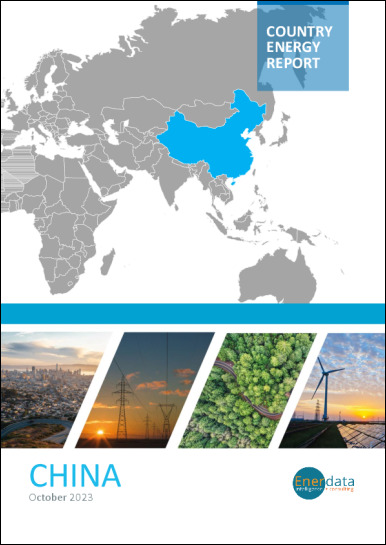- Update
-
- Format
- 4 files (PDF report, 3 Excel files)
- Pages
-
76 (Report only)
- Delivery
- Immediate by e-mail
- GENERAL OVERVIEW
- ENERGY AND CLIMATE POLICY FRAMEWORK
- ENERGY COMPANIES
- ENERGY SUPPLY AND DEMAND
- ENERGY USE AND PRICE BY SECTOR
- ISSUES AND PROSPECTS
- STATISTICS
- ABBREVIATIONS
- GLOSSARY
Buy China energy report
Price without VAT. Depending on your statute and location, VAT might be applicable. Get in touch with us for more information.
After validation, you will immediately receive 4 files by email (one pdf report and 3 excel files containing the datasets).
Overview
China’s energy and climate policy framework centres on achieving carbon neutrality by 2060, with interim targets to reduce greenhouse gas emissions and expand non-fossil fuel use. Key agencies, including the National Energy Administration and National Development and Reform Commission, oversee policy implementation, while provincial governments and state-owned enterprises play pivotal roles in energy management. Recent reforms prioritise renewable energy, market liberalisation in electricity and gas sectors, and advancements in hydrogen and nuclear power, alongside efforts to modernise coal and oil industries while balancing economic growth with emissions reduction.
Get more details on the table of contents and data files, as well as the list of graphs and tables by browsing the tabs below.
Highlights
- To reach carbon neutrality by 2060, China intends to lower its GHG emissions by 7-10% by 2035 from peak levels and to raise the share of non-fossil fuels in total energy consumption to over 30%.
- The 5 largest power companies account for 40% of installed capacity.
- CNPC dominates oil and gas production, with 50% of total output.
- Wind and solar surpassed thermal power in total capacity for the first time in 2024.
- China accounted for 55% of global coal consumption in 2024 and 34% of global CO2 emissions from fuel combustion.
- Final consumption is growing rapidly (over 5%/year). Electricity accounts for 27% of this consumption (+8 pp since 2010).
- Although subsidy cuts have been announced, renewables are still attracting investors with large-scale projects.
- Despite a cap on coal mine production, new projects continue to increase coal capacity.
Energy & Climate Policy Framework
NEA, the National Energy Administration, coordinates the national energy policy, manages energy conservation, and provides guidance about the integrated use of resources.
NDRC, the National Development and Reform Commission of the China State Council, formulates and implements medium and long-term strategies on social and economic development.
Energy Companies
Gas:
CNPC dominates the gas sector: its production rose by 4% to 145 bcm in 2024, including 140 bcm in China (+5%) and 5 bcm overseas (-8%). The group held 1 178 bcm of proved gas reserves in 2023 (+0.5%). CNPC sold more than 288 bcm of gas (2024).
Energy Supply & Demand
Resources:
Proven oil reserves are estimated at 3.7 Gt (at the end of 2024, reserves/production ratio of 16 years). Reserves of conventional natural gas are estimated at nearly 2 900 bcm in 2024 (13 years of production).
Energy Use and Price by Sector
Energy Prices in Residential:
Since 2021, electricity prices for households have declined by 5%/year to USD7.7c/kWh, while gas prices, which are set by local authorities and capped, have fallen by 3%/year to US3.8c/kWh.
Graph: Energy Prices in Residential (Taxes Included)

Issues & Prospects
The main priorities are to increase production, diversify the supply sources (for security reasons), and tackle rising emissions. The country also continues to reform the electricity sector.
- Graph 1: Final Intensity to GDP
- Graph 2: Primary Consumption Trends by Energy Source
- Graph 3: Total Consumption Market Share by Energy (2024)
- Graph 4: Installed Electric Capacity by Source
- Graph 5: Installed Electric Capacity by Source (2024)
- Graph 6: Gross Power Production by Source & Consumption
- Graph 7: Power Generation by Source (2024)
- Graph 8: CO2 Intensity of Electricity Generation
- Graph 9: Crude Oil Production & Consumption
- Graph 10: Petroleum Products Production & Consumption
- Graph 11: Gas Production & Consumption
- Graph 12: Coal Production & Consumption
- Graph 13: GHG Emissions and CO2-energy Emissions
- Graph 14: CO2-Emissions per Capita
- Graph 15: CO2 Intensity to GDP
- Graph 16: Final Demand Trends by Energy Source
- Graph 17: Final Consumption by Sector
- Graph 18: Final Consumption Market Share by Sector (2024)
- Graph 19: Share of Electricity in Total Final Energy Consumption
- Graph 20: Final Consumption in Industry by Energy Source
- Graph 21: Energy Prices in Industry (Taxes Included)
- Graph 22: Final Consumption in Transport by Energy Source
- Graph 23: Energy Prices in Transport (Taxes Included)
- Graph 24: Final Consumption in Residential, Services, Agriculture by Energy Source
- Graph 25: Energy Prices in Residential (Taxes Included)
- Graph 26: Upcoming New Capacity by Energy Source
- Economic Indicators: Annual historical data including population, GDP growth, imports and exports, inflation rate, energy security and efficiency indicators, CO2 emissions.
- Supply Indicators: Historical data including oil and gas reserves, electric and refining capacity, energy production, power production and external trade. All are detailed by energy source.
- Demand Indicators: Historical data including consumption per inhabitant, consumption trends, total consumption by energy source, final consumption by energy source and sector, and electricity consumption by sector.
- Energy Balances: Single table displaying the overall energy industry balance per annum, also graphically displayed by energy sub-segment.
The China energy market data since 1990 and up to
is included in the Excel file accompanying the China country report.
It showcases the historical evolution, allowing users to easily work with the data.
Key Data included in the excelsheet:
- Economic indicators: Annual historical economic indicators, energy security, energy efficiency and CO2 emissions.
- Supply indicators: Annual historical reserves, capacity, production and external trade (imports(+) exports(-) balance).
- Demand indicators: Annual historical consumption per capita, consumption trends, total consumption, final consumption (per energy and per sector) and electricity consumption total and per sector.
- Energy Balance: total and per energy.
- China Energy Prices: In addition to the analysis provided on the report we also provided a data set which includes historical details on the China energy prices for the follow items: price of premium gasoline (taxes incl.), price of diesel (taxes incl.), price of electricity in industry (taxes incl.), price of electricity for households (taxes incl.), price of natural gas in industry (taxes incl.), prices of natural gas for households (taxes incl.), spot price of Brent and CO2 emissions (from fuel combustion).
The China country dashboards are complemented with country forecasts from EnerFuture (excel file) with scenario comparison.
Data included in the excelsheet:
- Demand: Primary energy consumption, final energy consumption, by fuel, by sector.
- Power: Electricity generation & capacities, by technology.
- CO2: Total CO2 emissions.
- Macro-economy: Main macro-economic assumptions.
- Key indicators: Energy intensity, share of renewables, CO2 emissions per capita and per unit of GDP.
 Energy and Climate Databases
Energy and Climate Databases Market Analysis
Market Analysis